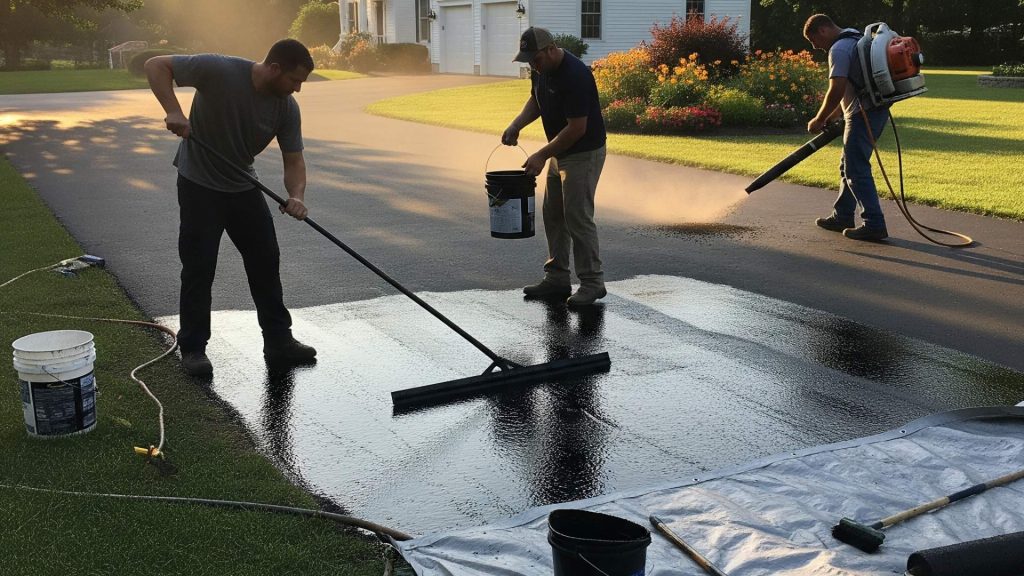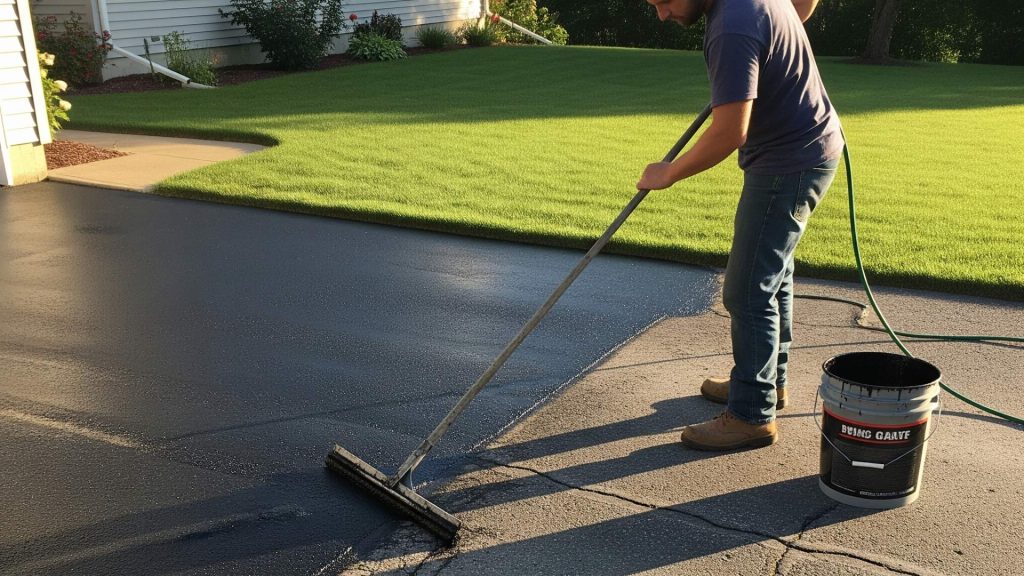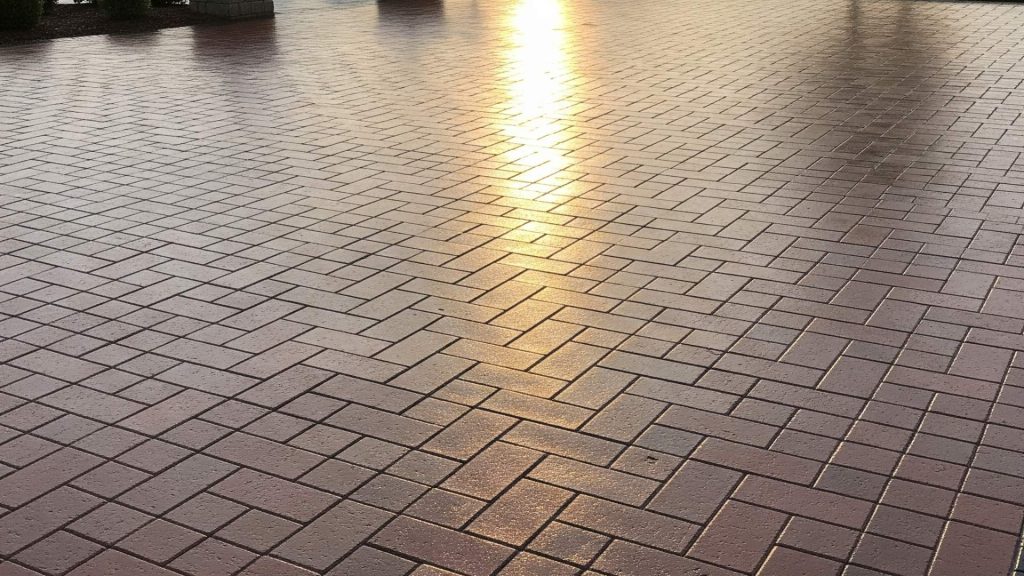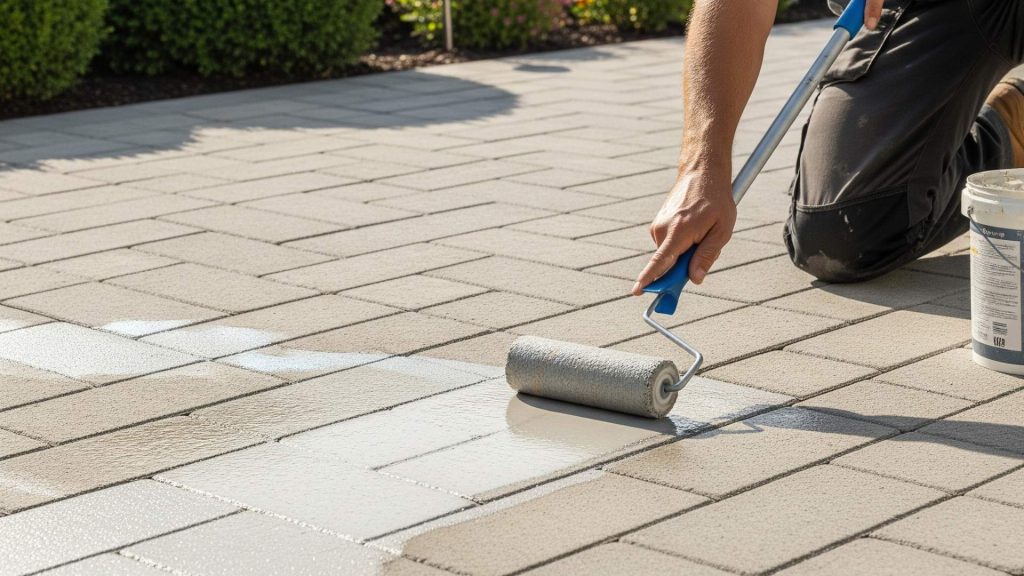Why Sealing Matters More in Southwest Florida
Intense UV, heavy summer rains, sandy soils, and coastal salt exposure can all take a toll on pavers. Left unprotected, these elements can fade color, wash out joints, and encourage slippery films or weed growth. A well-chosen sealer tackles all three challenges at once:
- Protection: Repels water, oils, rust, and organic stains (leaves, tannins), and reduces salt intrusion around saltwater pools and gulf‑side patios.
- Stability: Works with polymeric sand to harden joints, discouraging weeds and ants while reducing washout during heavy rain.
- Aesthetics: Restores color on concrete pavers, deepens tone for a wet look (optional), or keeps natural stone looking authentically matte with a breathable penetrating formula.
What Type of Sealer Is Best ? (By Material & Use)
Not all sealers perform the same in our climate. Here’s how we match products to projects around Park Shore, Pelican Bay, and Golden Gate Estates.
Travertine (Pool Decks, Patios, Walkways)
- Best Match: Breathable penetrating sealer (natural or enhanced).
- Why: Travertine is a porous natural stone. A breathable formula protects against moisture and salt without trapping vapor (which can create a hazy look).
- Finish Options: Natural‑matte that keeps the stone’s character, or an enhancing penetrating sealer that gently enriches color without forming a thick film.
- Add‑Ons: Anti‑slip micro‑grit for wet zones; salt‑resistant chemistry for saltwater pools.
Porcelain (Lanais, Pool Decks, Modern Patios)
- Best Match: The tiles themselves are extremely dense, so we typically seal the joints, not the porcelain body.
- Why: Porcelain’s very low absorption doesn’t benefit from film build. Focus on joint stabilization and stain resistance for grout/joint sand.
- Add‑Ons: Non‑slip is built into most outdoor‑rated porcelains; still, confirm DCOF traction ratings for splash zones.
Concrete Pavers (Driveways, Paths, Patios)
- Best Match: Two good approaches depending on goals:
- Penetrating natural‑look sealer for subtle protection and low maintenance.
- High‑quality film‑forming sealer (matte–gloss range) for color pop and richer tone.
- Why: Concrete benefits visually from refresh cycles; the right film helps with color retention and cleanability.
- Add‑Ons: Non‑slip additive (especially on inclines/wet areas). Choose UV-stable, non-yellowing chemistry for intense sun.
Permeable Pavers & High‑Drainage Areas
- Best Match: Penetrating, breathable products designed for permeability systems.
- Why: Maintain infiltration rates while giving joints extra stability.

Water‑Based vs Solvent‑Based Sealers in Coastal Florida
- Water‑Based (Low VOC): Our go‑to for most projects—lower odor, compliant near sensitive coastal zones, fast re‑coat, and modern resins are extremely durable. Excellent for travertine and concrete with anti‑slip additives.
- Solvent‑Based: Can deliver deep gloss and strong film in certain cases, but they involve higher VOCs and more curing sensitivity. We use these selectively where their specific benefits outweigh the trade‑offs.
Bottom line: In Collier County, we default to high‑quality water‑based chemistries unless your project has unique needs.
How Often Should You Seal Pavers ?
Sealer life depends on sun exposure, traffic, material, and proximity to salt. Use these local rules of thumb:
- Travertine pool decks & lanais: Every 2–3 years with a breathable penetrating sealer. Very sunny or salt‑exposed locations may need refresh closer to 24 months.
- Concrete driveways: Every 2–3 years (more frequent on high‑traffic or southern‑exposed surfaces).
- Porcelain installations: Joints typically need attention every 2–4 years; the tile faces usually do not require sealing.
- Permeable systems: Inspect annually; reseal joints every 2–3 years depending on washout and traffic.
Signs it’s time to reseal:
- Water no longer beads on the surface.
- Color looks dull or chalky on concrete pavers.
- Polymeric sand erodes or weeds/ants reappear.
- You notice rust/organic stains that don’t lift with a neutral cleaner.

The Correct Sealing Process (Step‑by‑Step)
- Inspection & Prep
We walk your site to check for loose edges, low spots, or joint loss. Pavers that have shifted get re‑set now—sealer won’t fix level issues. - Deep Cleaning
We remove organics, grease, and mildew using the right chemistry for your material. For concrete efflorescence, we treat the carbonate salts before sealing. Gentle pressure with proper tips prevents joint blow‑out. - Joint Re‑Sand (Polymeric Sand)
After cleaning and drying, we sweep in polymeric sand, vibrate/compact for depth, and activate it with controlled misting. This step locks the surface, deters weeds, and prevents washout during summer storms. - Drying/Curing Window
We allow the surface to dry thoroughly—critical in our humidity. Rushing here can trap moisture and cause haze. - Sealer Application
Using pro sprayers/rollers, we apply even coats suited to your material and finish preference. On pool decks, we can add non‑slip micro‑grit. - Quality Check & Cleanup
We correct any lap lines or missed joints, test beading, and clear work areas. You get a printed care sheet with your reseal date and recommended next service window.
Typical access times:
- Foot traffic: 24 hours (faster for some water‑based formulas).
- Vehicle traffic: 48–72 hours on driveways, weather permitting.
Common Mistakes (and How We Avoid Them)
- Over‑sealing/too many coats: Leads to whitening or peeling under UV. We measure coverage and stick to manufacturer specs.
- Sealing too soon after install or a heavy storm: Moisture trapped beneath the film causes blush. We check surface and core moisture before application.
- Using non‑breathable film on natural stone: Traps vapor; we use breathable penetrating sealers for travertine.
- Blasting joints with high pressure: Erodes sand and weakens the system. We use the lowest effective pressure and proper tips.
- Skipping efflorescence treatment: Sealing over salts locks in haze. We remediate first, then seal.
- Ignoring edge restraint problems: If pavers creep, sealing won’t stop it. We reset and restrain edges before sealing.

What Results to Expect: Natural vs Wet‑Look
- Natural/Matte (Travertine or Concrete): Keeps the authentic texture with subtle color enrichment. Great for coastal, classic designs in Pelican Bay.
- Enhanced/Wet‑Look (Concrete): Visibly deepens color and adds a light sheen to patterns on driveways and patios; often chosen in Golden Gate Estates where bold borders and inlays are popular.
- Porcelain: Appearance changes very little—benefits are in clean joints and stability.
If you’re unsure, we can sample a small test area so you can compare finishes in your own sunlight.
Sealer Selection at a Glance (Quick Matrix)
- Travertine, pool deck, saltwater: Breathable penetrating, natural or enhanced + anti‑slip; reseal 2–3 years.
- Travertine, shaded lanai: Penetrating, enhanced optional; reseal 3 years typical.
- Porcelain, pool deck: Seal joints only; check DCOF; refresh 2–4 years.
- Concrete driveway: Film‑forming or penetrating depending on look; non‑slip on slopes; reseal 2–3 years.
- Permeable pavers: Penetrating to maintain infiltration; monitor joints annually.
Seasonal Timing (When to Seal)
While Pavers Of Naples seals year‑round, the best windows are typically late fall through spring when humidity and storm risk are lower. Use this simple care calendar:
- January–March: Rinse, spot‑clean, and plan reseals before pool season.
- April–June: Reseal windows open; confirm 24–48 hours of dry weather after service.
- July–September: Heavy rains—focus on inspection, sand top‑ups, and drainage checks.
- October–December: Prime time for driveway reseals and patio refreshes before holiday guests.
Cost & Value (What Affects Pricing)
We price sealing by square footage, material, access, cleaning needs, repairs, and finish selection. Pool decks with many cut‑outs, heavy stain remediation, or joint replacement take more time than a straightforward driveway refresh. What you get back is longer surface life, less staining, tighter joints, and a patio or driveway that looks new again.
FAQs
How long does paver sealing last ?
Most projects last 2–3 years before a refresh, depending on sun, traffic, and salt exposure. Porcelain joints may go longer; concrete driveways at full sun may need earlier touch‑ups.
Is sealing slippery?
Not when finished correctly. We use non‑slip additives on pool decks, lanais, and slopes so traction stays strong—even when wet.
Can sealing fix loose or sinking pavers?
No. Sealing protects the surface and joints, but base and edge issues must be repaired first. We reset and compact before we seal.
Will a wet‑look sealer turn white?
Whitening (blushing) happens when moisture gets trapped or too much product is applied. We use breathable formulas, respect coverage rates, and ensure the surface is dry.
Do porcelain pavers need sealing?
The porcelain body usually doesn’t. We focus on sealing the joints and keeping the textured surface clean with neutral cleaners.
Can I pressure wash sealed pavers?
Yes—light to moderate pressure with the right tips. Avoid getting too close to joints; think clean, not carve. Re‑sand joints if you notice washout.
Seal Smarter, Not Just More Often
The right approach is material‑specific, breathable where needed, and backed by joint stabilization. Done correctly, sealing keeps your pool deck cool and clean, your driveway vivid and durable, and your patio ready for every gathering—from Park Shore sunsets to Golden Gate Estates cookouts.

